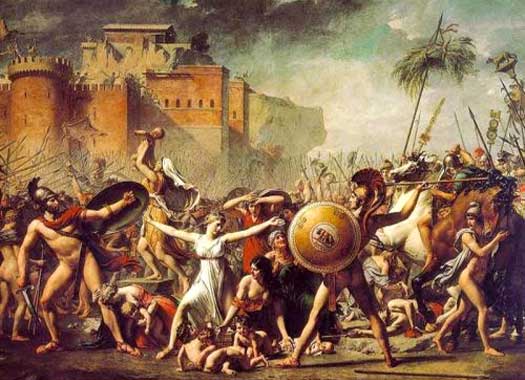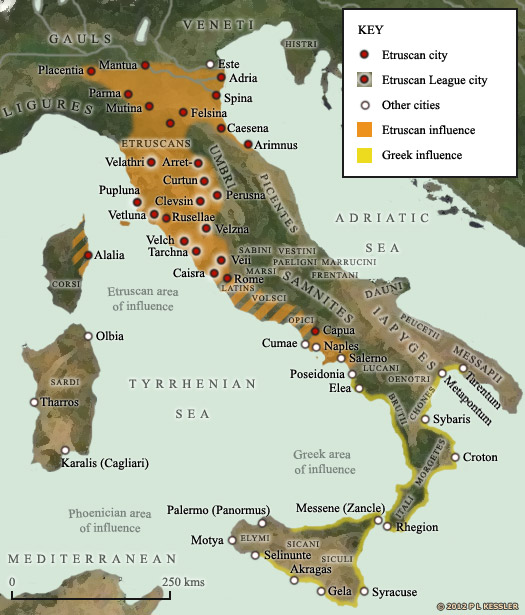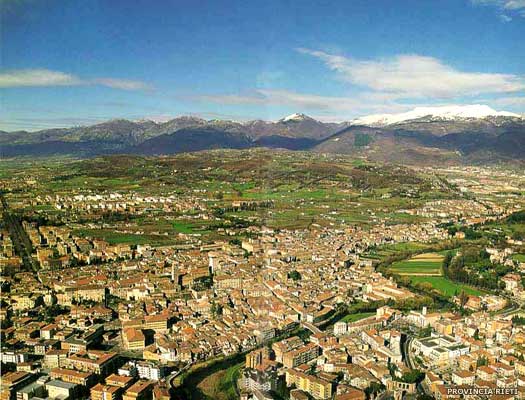| Sabus |
Son of Sancus. Eponymous founder figure of the Sabini. |
|
| c.11th century BC |
Lista, the 'metropolis' of the earlyLatins, is destroyed by the Sabini of Amiternum in a night attack. The inhabitants are never able to recover it and are seemingly forced westwards by the event, into the territory of theSiculi around the River Tiber. If true, this event which is taken from Varro and which is supported by Portius Cato would seem to mark the arrival of the Latins in the territory in which Rome would later be founded. The Sabini from Amiternum settle their newly-conquered Reatine territory, inhabiting the largest settlement in the region, which is called Cotyna, or Cotylia. They send out colonies which build many settlements in the neighbouring regions, and they also found the city of Cures. |
|
| 8th century BC |
With the beginning of the Italian Iron Age, signs of territorial variation begin to emerge, although the gradual differentiation between a western area, an eastern area, and an Alpine area will only acquire more consistency in the seventh century BC. This is the Golasecca I A period.By this time, the Sabini occupy territory between the River Teverone (Latin Anio, modern Aniene), which forms a border with the Romans, and the settlement of Nursia (modern Norcia), high in the Apennines. Two cities that lie nearest the Roman border are Eretum and Cures, while Varia lies on the Teverone. The biggest settlement is Reate (modern Rieti) on the River Velino (approximately midway between Nursia and Rome), and the many substantial satellite settlements in the region of Reate include Interocrea, Amiternum, Foruli, Cutilae, and Trebula Mutuesca. |
|
| ? - 748 BC |
Titus Tatius |
Sabine king of Cures. Joint ruler of Rome (753-748 BC). |
| 753 BC |
The city of Rome is built and many landless and homeless men settle in it, swelling the nascent population. The city's founder, Romulus, raids the neighbouring Sabine tribes for women, which sparks war between the two. The (possibly legendary) Sabine ruler, Titus Tatius, storms the city and battle is joined, but thanks to the intervention of the Sabine women themselves, the two agree peace terms. The Sabines share Rome, settling on the Quirinal, and the two kings rule jointly, also doubling the size of the Senate and the early legions. This union creates a split in the Sabine tribes. The Sabines of Rome become fully integrated into the growing city, while those in the mountains continue to oppose the city's growth and increasing domination of the region.  The Sabine Women, painted by Jacques-Louis David, depicts the intervention of the captured Sabine women in the fighting between Sabines and Romans The Sabine Women, painted by Jacques-Louis David, depicts the intervention of the captured Sabine women in the fighting between Sabines and Romans |
|
| 748 BC |
Tatius is killed by the Latin inhabitants of Lavinium out of revenge for his sheltering of allies who have plundered that settlement. This ends the joint kingship of Rome and Romulus continues to rule alone. Tatius' daughter is Tatia, and she marries Numa Pompilius, thereby giving him a legitimate claim to the Roman throne. Tatius' successor in Cures is unknown, but his unnamed son is a possibility. |
|
| 748 - 717 BC |
Having already subdued the Alban colony of the Camerini with Tatius, over the course of the next thirty years, Romulus goes on to expand Rome's territory. He conquers the Etruscan town of Fidenae, and defeats the Crustumini, but his rule grows increasingly dictatorial. Eventually it seems that he is killed by the weary Senate, with the deed being hidden by claiming that Romulus has ascended to heaven. |
|
| 716 BC |
Following the untimely death of the founder ofRome, the Sabine Numa Pompilius is elected to be his successor after a year of deliberation by the Senate. His reign of forty-four years is relatively peaceful, in contrast to the frequent wars of expansion of Rome's earliest years. |
|
| c.660s/650s BC |
King Tullus Hostilius ofRome goes to war against the Sabini. The cause seems to be little more than an excuse, with Hostilius claiming that Roman merchants have been seized at a market while the Sabini claim in return that some of their people are being detained in Rome. The Sabini gain the help of volunteers from the Etruscan city of Veii, although no official support is forthcoming. In a battle in the forest of Malitiosa, the larger and stronger forces of Hostilius, augmented by Alban units, scatter the Sabini and inflict heavy casualties on them as they retreat. |
|
| c.650 - 550 BC |
Umbrian graves excavated in 1997 can be dated to this period. An ancient necropolis with at least thirty-six burials is discovered in the modern city of Terni, north ofRome. The graves contain an equal mix of men and women, along with a couple of children, and grave good include Etruscan bronze bowls, and Etruscan bucchero and Sabine-Faliscan pottery. |
|
| c.586/585 BC |
Livy describes how Tarquinius Priscus is preparing to construct a wall aroundRome when the Sabini attack. The engagement is bloody but inconclusive and the Sabini withdraw to their encampment. A second battle is fought the next day, this time with Rome bringing up a much stronger force which ultimately breaks the Sabini, inflicting great slaughter on their number, many of whom drown in the River Teverone. With the conflict now escalating, Tarquinius proceeds into Sabini territory and inflicts another defeat on fresh forces. The Sabini sue for peace and relinquish control of the town of Collatia (nothing of which remains today).  This map shows the greatest extent of Etruscan influence in Italy, during the seventh to fifth centuries BC, including the Campania region to the south (click or tap on map to view full sized) This map shows the greatest extent of Etruscan influence in Italy, during the seventh to fifth centuries BC, including the Campania region to the south (click or tap on map to view full sized) |
|
| 505 BC |
Again it is Livy who records fresh conflict between the Sabini and the now-republic of Rome. Again the Sabini come off second best, and the two Roman consuls of this year celebrate a triumph in Rome. |
|
| 504 BC |
Lucius Tarquinius Superbus (the Proud) |
Appointed dictator. Former king ofRome. |
| 504 BC |
Lucius Tarquinius Superbus is appointed dictator of the Sabini, who play a leading part in the fresh conflict that erupts against Rome. The Fidenates (of the former Etruscan town of Fidenae) and Camerians (of the settlement of Cameria) are brought in to assist them. The allied army marches on Rome and is stopped at the River Teverone (Latin Anio, modern Aniene). A planned night attack by the Sabini is leaked to the Romans, and turns into a Sabini massacre. Tarquinius manages to escape but his campaign (and presumably his dictatorship of the Sabini) comes to an end. |
|
| 486 BC |
The Hernici, who live between the Aequi andVolsci, have become highly adapted to Latin culture and customs. Under pressure from their two neighbours, they join the mutual protection treaty between theRomans and Latins. The armies defending Latium now consist of Romans, Latins and Hernici. The Aequi and Volsci remain allied in opposition to Rome. As time passes and the Roman alliance grows more essential to survival, the Hernici are absorbed into Latin culture and largely vanish as a separately identifiable people. |
|
| 449 BC |
Rome defeats the Sabini and Aequi in two battles, as recorded by Livy. This seems to be the first appearance of the Aequi, suggesting that the Sabini have further divided in the half century since the dictatorship of Tarquinius. Such division and fragmentation is common in Iron Age Italy in tribes that are repeatedly defeated by Rome - the Opici are a prime example of this effect. The Sabini themselves are seemingly so shattered by this latest defeat that they remain virtually unheard of thereafter. |
|
| 431 - 377 BC |
TheVolsci control much of southern Latium (Cora, Velitrae, Satricum, and Antium), and they continue to pressure the Latins. In addition, the Aequi are said to reach Rome itself, and a decisive battle between the Latins and the Volsci appears to be fought in this year. The Romans, under the command of A Postumius Tubertus, again meet the Aequi at the Algidus Pass, but this time they are victorious. With this victory the Romans are able to open an aggressive offensive which the Volsci are unable to withstand forever. By the 390s the Romans and Latins have regained control of the plains and have relegated the Aequi and Volsci to the western highlands. The Volsci are finally defeated with the capture of the port of Antium in 377 BC. The defeated Aequi are doomed to be destroyed within the century. |
|
| 304 BC |
Following the final defeat of the Samnites at the end of the Second Samnite War against Rome, and the Roman destruction of the Aequi, the Frentani, Marsi, Marrucini, andPaeligni voluntarily accept their reintegration into Roman administrative rule. This period proves to be the end for the Golasecca culture within the Italian Iron Age.  The Sabini settlement of Reate (modern Rieti) was founded by the Sabini and prospered under Roman control to survive into the modern age The Sabini settlement of Reate (modern Rieti) was founded by the Sabini and prospered under Roman control to survive into the modern age |
|
| 303 - 290 BC |
Rome consolidates its hold over the central Apennines by founding colonies at Sora and Alba Fucens (on the Aequi frontier with theMarsi) in 303 BC, and Carseoli in 298 BC. A short-lived revolt by the neighbouring Marsi in 302 BC results in the loss of some of their territory to Rome, but in 290 BC the Sabini themselves are thoroughly conquered and are granted civitas sine suffragio. |
|
| 268 BC |
The Sabini are granted full Roman citizenship. Thereafter, they are gradually absorbed within Roman Italy and lose their individual identity. Elements of their language survive integration and are later evident in Latin, amounting to perhaps a hundred words, while no Sabini inscriptions survive. The Via Salaria, the Roman 'Salt Way', is built to link Rome to Reate and the Adriatic coast on the other side of Italy. During the Lombard period in the sixth century AD, Reate continues to be an important town within the duchy ofSpoleto. |
|
 |
|
|
 Their language came from the Oscan-Umbrian group of Indo-European languages (P-Italic), which were widely spoken in Iron Age central and southern Italy before the rise to dominance of Latin (Latin itself was a slightly more distantly related language, coming from the Indo-European Latino-Faliscan group, or Q-Italic). The Aequi were thought to be a division of the Opici (or at least their Ausones stem), and therefore very closely related to the neighbouring Sabini. Strabo and Pliny, along with other ancient writers, claim the Aequi, Hernici, Sabini, and Volsci as divisions of the Sabellians and therefore of the older Opici or Ausones. According to Strabo, the Picentes were former Sabini who had migrated northwards, following their ritually-selected animal the woodpecker as they sought out a new homeland, while the Samnites, also former Sabini, migrated south where they dominated the Apennine range. Ovid also claims the Paeligni as a branch of the Sabini. (Information by Peter Kessler, with additional information by Edward Dawson, from Researches into the Physical History of Mankind, Vol 3, Issue 1, James Cowles Prichard, from An Historical Geography of Europe, Norman J G Pounds (Abridged Version), and from External Links: Geography, Strabo (H C Hamilton & W Falconer, London, 1903, Perseus Online Edition), and The Natural History, Pliny the Elder (John Bostock, Ed).)
Their language came from the Oscan-Umbrian group of Indo-European languages (P-Italic), which were widely spoken in Iron Age central and southern Italy before the rise to dominance of Latin (Latin itself was a slightly more distantly related language, coming from the Indo-European Latino-Faliscan group, or Q-Italic). The Aequi were thought to be a division of the Opici (or at least their Ausones stem), and therefore very closely related to the neighbouring Sabini. Strabo and Pliny, along with other ancient writers, claim the Aequi, Hernici, Sabini, and Volsci as divisions of the Sabellians and therefore of the older Opici or Ausones. According to Strabo, the Picentes were former Sabini who had migrated northwards, following their ritually-selected animal the woodpecker as they sought out a new homeland, while the Samnites, also former Sabini, migrated south where they dominated the Apennine range. Ovid also claims the Paeligni as a branch of the Sabini. (Information by Peter Kessler, with additional information by Edward Dawson, from Researches into the Physical History of Mankind, Vol 3, Issue 1, James Cowles Prichard, from An Historical Geography of Europe, Norman J G Pounds (Abridged Version), and from External Links: Geography, Strabo (H C Hamilton & W Falconer, London, 1903, Perseus Online Edition), and The Natural History, Pliny the Elder (John Bostock, Ed).) The Sabine Women, painted by Jacques-Louis David, depicts the intervention of the captured Sabine women in the fighting between Sabines and Romans
The Sabine Women, painted by Jacques-Louis David, depicts the intervention of the captured Sabine women in the fighting between Sabines and Romans This map shows the greatest extent of Etruscan influence in Italy, during the seventh to fifth centuries BC, including the Campania region to the south (click or tap on map to view full sized)
This map shows the greatest extent of Etruscan influence in Italy, during the seventh to fifth centuries BC, including the Campania region to the south (click or tap on map to view full sized) The Sabini settlement of Reate (modern Rieti) was founded by the Sabini and prospered under Roman control to survive into the modern age
The Sabini settlement of Reate (modern Rieti) was founded by the Sabini and prospered under Roman control to survive into the modern age